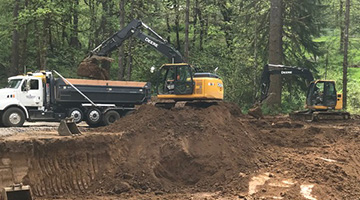Comprehensive Exploration: The Science Behind Superior Excavation Practices
From old hand devices to contemporary hydraulic excavators, the advancement of excavation strategies has actually been a testimony to human ingenuity and technological developments. What truly sets remarkable excavation techniques apart is a deep understanding of geological concepts, coupled with the application of innovative tools and methods.
Advancement of Excavation Techniques
Throughout background, the development of excavation techniques has played a critical function beforehand construction techniques and archaeological explorations. From the basic devices made use of by our ancestors to the innovative machinery utilized in modern-day times, the progression of excavation techniques has actually considerably changed how we approach different tasks.
In ancient times, hands-on labor with standard tools such as pickaxes, wheelbarrows, and shovels was the key method of excavation. This labor-intensive process restricted the deepness and range of excavations, commonly causing sluggish progression and limited access to certain sites. As human beings advanced, so did the techniques and tools used for excavation.
The Industrial Transformation marked a turning point in excavation techniques with the intro of steam-powered equipment. In contemporary times, innovation plays a critical role in excavation, with advancements like GPS systems, drones, and 3D scanning boosting accuracy and performance in the area.
Duty of Modern Technology in Excavation

The combination of sophisticated technology has actually fundamentally transformed the field of excavation, boosting precision and effectiveness to extraordinary levels - dump truck companies in ohio. One of the key technological innovations that has considerably influenced excavation techniques is the utilization of GPS systems.
Moreover, the introduction of 3D modeling and simulation software application has structured the planning process for excavation projects. Operators and designers can currently envision the entire excavation process before breaking ground, maximizing and recognizing possible challenges operations. Together with this, the implementation of drones in excavation tasks has actually facilitated aerial surveys, volumetric measurements, and site evaluations with unequaled rate and precision.
Geological Concepts in Excavation
An understanding of geological principles is crucial for ensuring the structural integrity and stability of excavation sites. Geological factors play an essential duty in identifying the usefulness and safety of excavation tasks (excavating ohio). One essential geological principle to consider is the type of dirt or rock existing at the website. Different soil types, such as gravel, sand, or clay, have differing degrees of stability and require different excavation strategies. Cohesive soils like clay might need extra support to protect against collapses, while sandy dirts may be prone to disintegration throughout excavation.
Additionally, the geological framework of the area, including mistakes, fractures, and rock developments, should be carefully analyzed to determine potential dangers and challenges. Digging deep into near fault lines or unpredictable rock formations can lead to instability and prospective hazards. By performing extensive geological studies and analysis, excavators and engineers can create techniques to minimize dangers and make certain the successful conclusion of excavation projects. Inevitably, incorporating geological concepts right next page into excavation methods is critical for accomplishing secure, efficient, and lasting outcomes.

Latest Tools for Excavation
In the world of excavation techniques, modern technologies in devices have actually reinvented the effectiveness and accuracy of excavation processes. These drones can offer comprehensive aerial surveys of excavation websites, supplying real-time data on topography and potential risks.
Another company website cutting-edge device obtaining appeal is the application of 3D printing innovation for producing customized excavation equipment. This enables the manufacturing of specialized devices that are tailored to the specific requirements of a job, enhancing effectiveness and reducing downtime.
In addition, developments in materials scientific research have brought about the advancement of stronger and more sturdy excavation tools. lancaster trenching. Tungsten carbide-tipped excavator attachments, as an example, deal superior efficiency in difficult ground conditions, boosting efficiency on-site
Scientific research's Effect on Excavation Practices

Additionally, scientific research study on dirt mechanics and geotechnical design has actually given beneficial understandings into soil habits, allowing excavation professionals to make enlightened decisions pertaining to excavation techniques and soil stabilization techniques. In general, science continues to drive technology and improvement in excavation techniques, making excavation tasks more efficient, affordable, and lasting.

Verdict
In verdict, the development of excavation strategies has been greatly affected by innovations in technology and a deeper understanding of geological concepts. The most recent tools and devices made use of in excavation have boosted effectiveness and precision in the area. The application of scientific expertise has actually dramatically improved excavation methods, causing extra efficient and lasting techniques for excavating different sorts of products.
In the world of excavation techniques, contemporary developments in devices have actually transformed the efficiency and accuracy of excavation processes. By leveraging clinical concepts, the excavation industry has actually been able to substantially boost performance, precision, and safety in excavation processes. GPR enables excavation groups to non-invasively check and map subsurface frameworks, energies, and prospective hazards, allowing them to plan excavation projects with better precision and lowered danger of accidents.
Furthermore, scientific research study on soil auto mechanics and geotechnical engineering has actually provided valuable understandings into dirt behavior, enabling excavation specialists to make educated decisions relating to recommended you read excavation techniques and dirt stabilization techniques. Generally, science proceeds to drive innovation and renovation in excavation techniques, making excavation tasks extra efficient, affordable, and lasting.